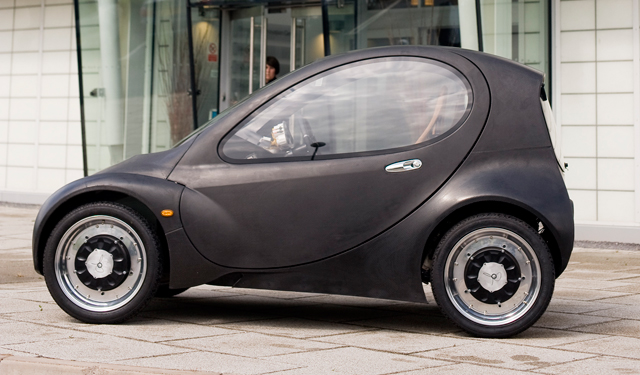It’s not actually about the car,” says Martin Wilderer. “We’re aiming to revolutionize the way people see mobility; the whole system. That’s where the power of our new venture comes from – not from only looking at one part of the mobility chain.”
His vision includes alliances with hydrogen-pumping filling stations, to allow motorists to continue their refueling habits as normal, but with a very different approach to motoring.
Rather than designing a good-looking car and shoving a modified engine inside, Riversimple has developed a hydrogen fuel cell as its heart and decided to manage the entire process, from car to filling station. It’s easy to brush off the geeky-looking prototype model as just another green alternative to driving, but Wilderer has taken in the role of CEO of U.K.-based Riversimple to develop a company that preserves the freedom of individual transport with the ease of a monthly leasing fee.
Along with four others who became equally disillusioned with a lack of sustainable solutions in the auto industry, Wilderer has been tasked with building the production lines needed to replicate the demonstrator, built by company founder Hugo Spowers. Along with Professor Steve Evans, director of the Centre for Industrial Sustainability at Cambridge, Sebastian Piëch, sustainability investor and maternal great-grandson of Ferdinand Porsche and renowned car designer Chris Reitz, the team has decided it’s time to eliminate the environmental impact of personal transport.
Spowers, a former racing engineer and the brains behind the venture, realized that high-powered fossil fuel engines simply cannot support our mobility needs for much longer and decided to move away from cars, only to find himself even more involved in the industry. With a hydrogen fuel cell and dramatic weight-shedding, he thinks he might have a meaningful and groundbreaking solution to sustainable mobility. Wilderer spent 10 years in China building production facilities for wastewater treatment and is now putting his expertise into rolling out the next generation of cars.
“The longer the car is on the road, the more money we make.”
“Trying to squeeze our new idea of mobility into existing concepts of the car won’t work. This will create an add-on cost to customers, who won’t buy into it,” says Wilderer. A core part of their plan is that they’re not actually selling the car, but rather mobility as a service. Customers will pay one monthly bill which includes fuel, tax, registration and licensing fees. Riversimple will retain ownership of the car while offering a super-efficient service to drivers.
By providing mobility as a service under a form of leasing arrangement, it means that the priorities are completely different. Established motor industry practice involves convincing drivers to replace perfectly serviceable vehicles with something more exciting every few years.
A Riversimple car, which may have several “owners,” will last for around 15 years. As Wilderer says: “The longer the car is on the road, the more money we make.” The car’s longevity is mainly due to the carbon fiber bodywork of the car, and the lack of moving parts (other than the wheels) and thus wear, a conscious effort to move away from the degradable nature of current vehicles. Aimed at the pre- and post-kid market, the two-seater car is seen as a vehicle to satisfy the needs of shopping and daily errands, and a complement to an existing gas-powered family car. “Why carry around a huge amount of weight to go grocery shopping when you only need a van-sized car once a year for the family holiday?” says Wilderer.
The young and the old might find this arrangement perfect for their needs, but how do you maintain the “thrill factor” of driving a car that looks and feels good among a large majority of car lovers? Enter Chris Reitz, the Austrian-born car designer who recently got fed up at his job leading the design for Fiat’s Alfa Romeo brand. Reitz helped develop one of Europe’s most popular cars, the Fiat 500, and it’s now his job to turn the internal workings of Spowers’ innovation into a desirable artwork that appeals to the fashion-minded consumer.
Surprisingly, the design will be “open source,” meaning that partners around the world could adapt it for local conditions. “We’re not only appealing to green geeks here, this will be a fun car,” explains Wilderer. “This is a fun car, which will include cool technology at affordable rates.” While acknowledging that the need for speed in a Porsche, or the off-road capabilities of a Land Rover, will still exist, and that battery-powered performance cars such as the Tesla will still appeal to many, Riversimple has seen the potential not only amongst those who need cheap and convenient everyday transport, but also in growing car pools around the world.
Unlike standard cars which have ever-increasing top speeds, Riversimple cars are designed to a specific acceleration figure and top speed, which is also the maximum cruise speed. Spowers has decoupled the workings of the engine, using supercapacitors to capture energy from braking and using it for acceleration, while using the fuel cell for cruising.
Much like the fighting techniques of many martial arts, which turn opponents’ force against them, the Riversimple car has captured a negative force to its advantage; in fact, Spowers calls it “Aikido” engineering. Local manufacturers will see the first plant produce 5,000 cars a year, with plans to grow as demand increases, lowering the financial start-up risk.
“We aim to provide a sustainable mobility plan with a zero percent excess cost compared to what customers already pay on standard vehicles. This is possible now, and we can still make a nice profit,” says Wilderer. Changing public perception around cars and fossil fuels has already primed the market for their new car and a planned social media campaign will fit snugly with a tech-savvy audience continually seeking out the next best thing.




































